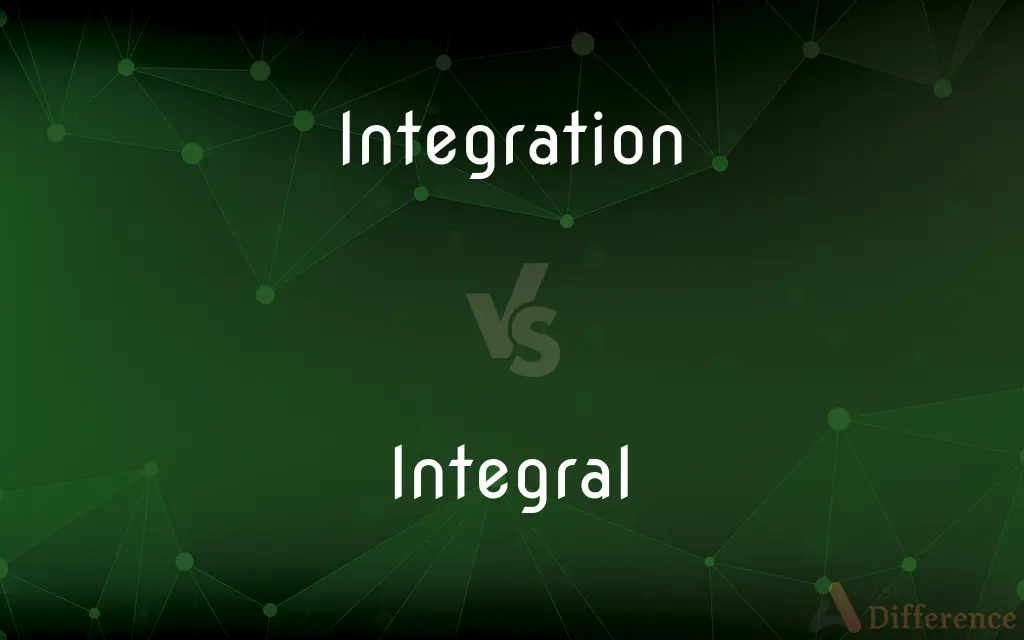Integration vs. Integral — What's the Difference?
Edited by Tayyaba Rehman — By Urooj Arif — Updated on March 16, 2024
Integration is the process of finding the integral, focusing on the method, while the integral represents the result, embodying the concept.

Difference Between Integration and Integral
Table of Contents
ADVERTISEMENT
Key Differences
Integration is a fundamental concept in calculus that involves finding the integral of a function. It is essentially the process of calculating the area under the curve of a graph of the function, across an interval. On the other hand, an integral is the result obtained from the process of integration.
Integration techniques, such as substitution, partial fractions, and integration by parts, are methods used to simplify and solve integrals. These techniques are essential for finding antiderivatives of complex functions, facilitating the integration process.
Integral formulas, such as those for basic functions, trigonometric functions, and exponential functions, provide a direct way to find integrals without going through the detailed process of integration. These formulas are crucial for efficiently solving integrals, especially in applied mathematics and physics.
The concept of integration extends beyond mathematics to fields like engineering, where it is used to model continuous systems and processes. For example, integrating a velocity function over time yields the total displacement, a practical application of the integral.
The concept of an integral is central to the theory of calculus and its applications, providing a concrete way to quantify accumulations like area and volume. Integrals are used in real-world scenarios, such as calculating the work done by a force over a distance or the flow of liquid through a pipe.
ADVERTISEMENT
Comparison Chart
Definition
The process of finding the integral
The result of integration
Types
Techniques (substitution, partial fractions)
Indefinite (no limits, +C) and definite (with limits)
Purpose
To determine the accumulation of quantities over an interval
To represent the accumulation of quantities
Application
Used in solving problems involving areas under curves and rates of change
Used to calculate areas, volumes, and other quantities
Representation
Generally involves an operation or a set of steps
Expressed as a function or a numerical value
Compare with Definitions
Integration
The process of summing parts to find a whole.
Integration in mathematics often involves finding the total area under a curve.
Integral
A mathematical expression representing the accumulation of quantities.
The area under a curve can be found using an integral.
Integration
The process of accumulating changes to find a total effect.
Integration of daily temperature changes gives the total variation over a period.
Integral
A tool for calculating areas, volumes, and total quantities.
The volume of a solid of revolution is calculated using an integral.
Integration
The act of calculating the area under a curve of a function across an interval.
The integration of the velocity function gives the displacement.
Integral
Constituting the undiminished entirety; lacking nothing essential especially not damaged;
A local motion keepeth bodies integral
Was able to keep the collection entire during his lifetime
Fought to keep the union intact
Integration
The application of integrating techniques to solve differential equations.
Integration is crucial in solving differential equations in physics.
Integral
The result of integrating a function.
The integral of speed with respect to time gives distance.
Integration
A method in calculus for finding antiderivatives.
Integration by parts is a technique used to integrate products of functions.
Integral
In mathematics, an integral assigns numbers to functions in a way that describes displacement, area, volume, and other concepts that arise by combining infinitesimal data. The process of finding integrals is called integration.
Integration
The act or process of integrating.
Integral
Necessary to make a whole complete; essential or fundamental
Games are an integral part of the school's curriculum
Systematic training should be integral to library management
Integration
The state of becoming integrated.
Integral
Of or denoted by an integer.
Integration
The bringing of people of different racial or ethnic groups into unrestricted and equal association, as in society or an organization; desegregation.
Integral
A function of which a given function is the derivative, i.e. which yields that function when differentiated, and which may express the area under the curve of a graph of the function.
Integration
(Psychology) The organization of the psychological or social traits and tendencies of a personality into a harmonious whole.
Integral
Essential or necessary for completeness; constituent
The kitchen is an integral part of a house.
Integration
(Mathematics) The process of computing an integral; the inverse of differentiation.
Integral
Possessing everything essential; entire.
Integration
(Electronics) The process of placing more than one integrated circuit on a single microchip.
Integral
Expressed or expressible as or in terms of integers.
Integration
The act or process of making whole or entire.
Integral
Expressed as or involving integrals.
Integration
The process of combining with compatible elements in order to incorporate them.
Integral
A complete unit; a whole.
Integration
(society) The process of fitting into a community, notably applied to minorities.
Integration into the city
Integral
A number computed by a limiting process in which the domain of a function, often an interval or planar region, is divided into arbitrarily small units, the value of the function at a point in each unit is multiplied by the linear or areal measurement of that unit, and all such products are summed.
Integration
(US) racial integration.
Integral
A definite integral.
Integration
(calculus) The operation of finding the integral of a function.
Integral
An indefinite integral.
Integration
(biology) In evolution, the process by which the manifold is compacted into the relatively simple and permanent; supposed to alternate with differentiation as an agent in species' development.
Integral
Constituting a whole together with other parts or factors; not omittable or removable
Integration
The act or process of making whole or entire.
Integral
(mathematics) Of, pertaining to, or being an integer.
Integration
The operation of finding the primitive function which has a given function for its differential coefficient. See Integral.
Integral
(mathematics) Relating to integration.
Integration
In the theory of evolution: The process by which the manifold is compacted into the relatively simple and permanent. It is supposed to alternate with differentiation as an agent in development.
Integral
(obsolete) Whole; undamaged.
Integration
The action of incorporating a racial or religious group into a community
Integral
(mathematics) One of the two fundamental operations of calculus (the other being differentiation), whereby a function's displacement, area, volume, or other qualities arising from the study of infinitesimal change are quantified, usually defined as a limiting process on a sequence of partial sums. Denoted using a long s: ∫, or a variant thereof.
The integral of a univariate real-valued function is the area under its curve; but be warned! Not all functions are integrable!
Integration
The act of combining into an integral whole;
A consolidation of two corporations
After their consolidation the two bills were passed unanimously
The defendants asked for a consolidation of the actions against them
Integral
(specifically) Any of several analytic formalizations of this operation: the Riemann integral, the Lebesgue integral, etc.
Integration
An operation used in the calculus whereby the integral of a function is determined
Integral
(mathematics) A definite integral: the result of the application of such an operation onto a function and a suitable subset of the function's domain: either a number or positive or negative infinity. In the former case, the integral is said to be finite or to converge; in the latter, the integral is said to diverge. In notation, the domain of integration is indicated either below the sign, or, if it is an interval, with its endpoints as sub- and super-scripts, and the function being integrated forming part of the integrand (or, generally, differential form) appearing in front of the integral sign.
The integral of on is , but the integral of the same function on diverges. In notation, , but .
Integral
(mathematics) An indefinite integral: the result of the application of such an operation onto a function together with an indefinite domain, yielding a function; a function's antiderivative;
The integral of is plus a constant.
Integral
The fluent of a given fluxion in Newtonian calculus.
Integral
Lacking nothing of completeness; complete; perfect; uninjured; whole; entire.
A local motion keepeth bodies integral.
Integral
Essential to completeness; constituent, as a part; pertaining to, or serving to form, an integer; integrant.
Ceasing to do evil, and doing good, are the two great integral parts that complete this duty.
Integral
Of, pertaining to, or being, a whole number or undivided quantity; not fractional.
Integral
A whole; an entire thing; a whole number; an individual.
Integral
An expression which, being differentiated, will produce a given differential. See differential Differential, and Integration. Cf. Fluent.
Integral
The result of a mathematical integration; F(x) is the integral of f(x) if dF/dx = f(x)
Integral
Existing as an essential constituent or characteristic;
The Ptolemaic system with its built-in concept of periodicity
A constitutional inability to tell the truth
Common Curiosities
What are the types of integrals?
There are indefinite integrals (without limits) and definite integrals (with limits).
Why is integration important?
Integration is crucial for solving problems involving areas, volumes, and other quantities that accumulate over an interval.
What are some common integration techniques?
Common techniques include substitution, partial fractions, and integration by parts.
How does the concept of integration extend beyond mathematics?
Integration is used in fields like engineering to model continuous systems and processes.
How do integral formulas help in solving integrals?
Integral formulas provide direct methods for finding integrals of basic functions, facilitating efficient problem-solving.
What does an integral represent?
An integral represents the accumulation of quantities, such as area, volume, or a total quantity.
What is integration in calculus?
Integration is the process of finding the integral of a function, often used to calculate areas under curves.
How is integration used in physics?
Integration is used to calculate quantities like displacement by integrating a velocity function over time.
Why are integration techniques essential in calculus?
Integration techniques are essential for simplifying and solving complex integrals, crucial in various applications of calculus.
How are integration and integral related?
Integration is the process, while the integral is the result of this process.
What is the purpose of the constant of integration?
The constant of integration represents an infinite number of possible antiderivatives, reflecting the general solution to an integral.
Can you give an example of a practical application of an integral?
Calculating the work done by a force over a distance is a practical application of an integral.
What is the difference between indefinite and definite integrals?
Indefinite integrals represent a family of functions and include a constant of integration, whereas definite integrals have specific limits and calculate a numerical value.
What is the significance of the area under a curve?
The area under a curve represents the integral of a function, important for calculating total quantities.
How do definite and indefinite integrals differ in representation?
Definite integrals are represented by numerical values, whereas indefinite integrals are expressed as functions plus a constant.
Share Your Discovery

Previous Comparison
Female vs. Woman
Next Comparison
Discipline vs. AttitudeAuthor Spotlight
Written by
Urooj ArifUrooj is a skilled content writer at Ask Difference, known for her exceptional ability to simplify complex topics into engaging and informative content. With a passion for research and a flair for clear, concise writing, she consistently delivers articles that resonate with our diverse audience.
Edited by
Tayyaba RehmanTayyaba Rehman is a distinguished writer, currently serving as a primary contributor to askdifference.com. As a researcher in semantics and etymology, Tayyaba's passion for the complexity of languages and their distinctions has found a perfect home on the platform. Tayyaba delves into the intricacies of language, distinguishing between commonly confused words and phrases, thereby providing clarity for readers worldwide.














































